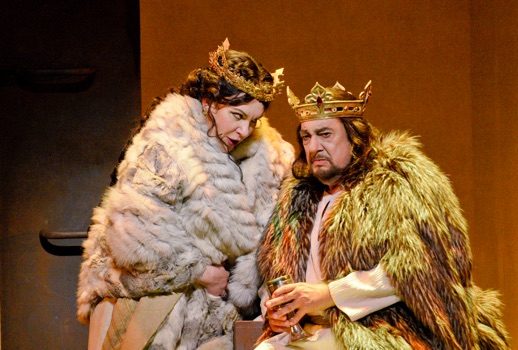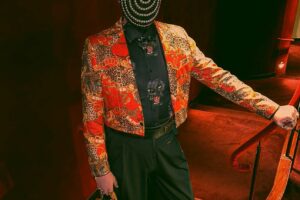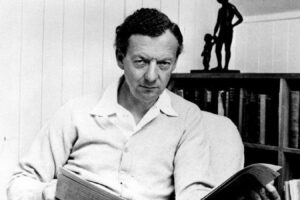

In my early days as an explorer of opera I was automatically drawn to Verdi’s work but since my introduction to the composer had been through his maturity after Un Ballo in Maschera, Aida, and Otello, it was difficult for me to wrap my head around this world of organ-grinder tunes with all this stopping, starting, and repeating. Only later after I had been exposed to Verdi’s middle-period along with a healthy dose of Donizetti and Bellini did I return to Macbeth with something approaching appreciation. Now with every new hearing I am fresh with wonder and admiration.
Performances of Macbeth are fairly rare however, due to the fact that you need an intrepid soprano with lungs of leather and a heart of ice, to say nothing of a star baritone who’s able to sell out a theater. The later not being an issue since the Grand Seigneur of LA Opera, Placido Domingo, has begun his Macbeth World Tour. Starting in Seville with recent stops in Beijing and now opening the season at the Music Center and playing through October 16.
Darko Tresnjak, who gave us a magnificent Ghosts of Versailles last year and whose Tony-winning Gentleman’s Guide to Love and Murder just played at the adjacent Ahmanson Theater on tour this summer, was asked back to give us his vision of Verdi’s early masterwork.
The unit set co-designed by Colin McGurk and the director looked straight out of an Orson Welles 1930’s Federal Theater Project. The full front wall of a castle with an upper loggia and one central doorway below opened onto a playing area spanning the stage, fronted with stairs interspersed with pedestals. Its simplicity and versatility were a benefit as well as its ability to boost the singers voices into the normally dry expanses of the Dorothy Chandler Pavilion. The chorus benefited from this especially and made an enormous impression just from sheer size of sound with not a little help from this acoustic shell that leaned discreetly forward.
Costumes by Suttirat Anne Larlarb, who has worked on many of Danny Boyle’s films and designed the ensembles for the Opening Ceremonies of the 2012 Olympics, were exactly what I have always wanted to see for a performance of Macbeth. Excellent fabrics, dark velvets, even some furs clad the vaguely medieval populace with nothing exaggerated or overdone. Even the crowns for Mr. and Mrs. Macbeth were paragons of simplicity and restraint.
Lighting by Matthew Richards worked hand in glove with the projections of Sean Nieuwenhuis. As the lights dimmed a chalk doorway appeared on the front curtain. It offered a vision into a foggy netherworld where you could barely make out text from the play. Later the lighting during the banquet scene was particularly nightmarish with an extraordinary moment when the ghost of Banquo disappeared and everything returned slowly to a reality of a clinical white/pale green glare.
The only part of the staging that deviated from Verdi and Shakespeare’s conventions were Mr. Tresnjak’s addition of a herd of apparently unidentifiable beasts explained by one member of the critical establishment as “a cross between Goyaesque gargoyles and the flying monkeys from The Wizard of Oz.” They crept about the stage, stirred the cauldron, and climbed its high walls in service of the witches who always stood in single file across the upper loggia.

That one quibble aside I lay all the glory for this performance at the feet of Music Director James Conlon. The LA Opera Orchestra ripped into this score with a ferocity and a technical skill that I have never heard before in an Verdi piece of this era. Conlon didn’t worry the music by getting over fussy with all of Verdi’s phantasmagorical effects. He landed each one, precisely judged and spontaneous sounding, and moved on.
His tempos, especially the ensemble with Macbeth, Banquo, and the male chorus after the witches pronouncements and “Fatal mi donna” in Act I, were fast, with a real excitement that made you sit forward in your seat like you were suddenly afraid you were going to miss something. He always kept a cantabile quality to the score and the tempos always related so perfectly to each other you heard the echos of the through-composed style that Verdi would later champion. Playing from the strings and the woodwinds was huge and the horn section never put a foot wrong all night and were on point in the fugue right before the final battle.
Arturo Chacón-Cruz was our Macduff and he was wonderful in his last act aria amongst the refugees once he was planted center stage and allowed to project straight out. He’s a light lyric with a little juice on top and a reedy sound. Just big enough for Verdi’s young men. There were some audibility problems whenever he had to move around too much but he had a sweet quality in the aria that was just right.
Roberto Tagliavini was the youthful sounding Banquo and he was a superlative Figaro here two years back. He brought a welcome youth and lyricism to the role that was especially poignant at times. Unstinting on the bottom portion of the voice, like all good Verdi basses, he had the grand line for “Come dal ciel precipita” and avoided driving into the gravel as you so often hear.
When casting was initially announced I remember being disappointed at the assignment of a mezzo-soprano for Verdi’s Lady. Not that I haven’t heard that happen before but it’s rare when you hear even a soprano with the range and technical skills to pull it off let alone a singer who rarely comes closer to the top of the staff than the occasional A-natural. Ekaterina Semenchuk needed no apologies in the role.
Once she was past an initial moment of approximatura on her first downward roulade in the recitative she proceeded to pile drive through ‘Vieni! t’affretta!’ with the most flagrant display of chest voice it has every been my pleasure to hear. The top was never, ever, tense or edgy and she was spot on in the multitude of staccatos sprinkled throughout the role. Spine tingling in both the central section of “La luce langue” and the repeat of the drinking song during the banquet scene, she pared down to an amazing pianissimo that carried perfectly into the theater.

But the real reason we’re enjoying all this sound and fury is so that Maestro Domingo can enjoy his hour upon the stage and be heard yet more and more. Since he has never been the kind of celebrity who hides his age with hair dye, it was something of a surprise to see him take the stage with a full head of shoulder length hair, looking 50 again.
The other intriguing thing about hearing a tenor in this role is that Domingo has always had an uncommonly ardent and sincere sound to his voice. He’s the only Macbeth I’ve ever heard who starts out actually sounding innocent. Especially later in “Fatal me donna” with Lady he’s really being talked into it.
Later in the evening when Domingo’s given himself over to the dark side you have to take his word for it because there’s just no malevolence in his timbre. At his current age of 75 it’s an astonishment that the voice itself has actually gained in resonance. True, he’s working harder at it than before. And he had a moment or two where his memory failed him but he knows how to cover better than anyone I’ve ever seen.
Two other things brought the majority of the excitement to this performance. In spite of what would be called Mr. Tresnjak’s conventional work here he does know how to keep a show moving and this production played seamlessly within its acts. He allowed for, and gave his performers, all their moments for audience recognition, thus cannily building the public’s reaction to the point where by the banquet scene (the evening played with one intermission) the audience was in a veritable frenzy at the end of Act II. The finale was capped by 15 minutes of curtain calls from a Los Angeles audience that normally bolts for the parking lot the moment the show is over.
The other reason was the work of the chorus. Though they numbered only 52, thanks to some strong young voices and the set’sdoing double duty as a band shell, they sounded easily like one hundred. In a work this chorus-heavy it was a thrilling and mighty sound to hear. For the chorus of the refugees “Patria oppressa” Tresnjak had the them huddled up towards the front of the stage while a lighting effect gave the impression of a river bank. A sole abandoned child sat center stage staring out in shock at nothing. They sang as one voice and matched each other’s dynamics flawlessly.
Performances run through the middle of October with Ildebrando D’Arcangelo stepping into Banquo’s boots for the last two. The performance of the 13 October is being streamed live on a jumbotron to the Santa Monica Pier and South Gate Park which is becoming something of a tradition for LA Opera.
Photos: Karen Almond/LA Opera


























Comments